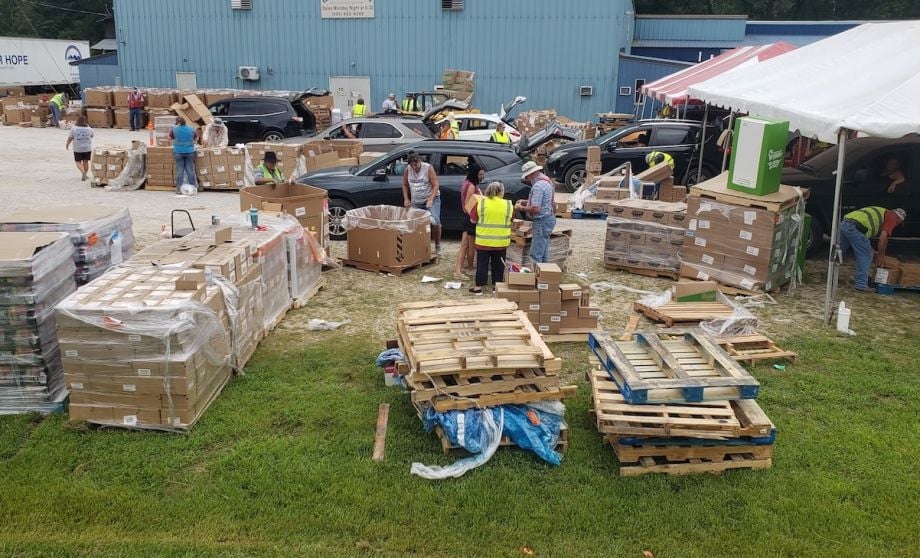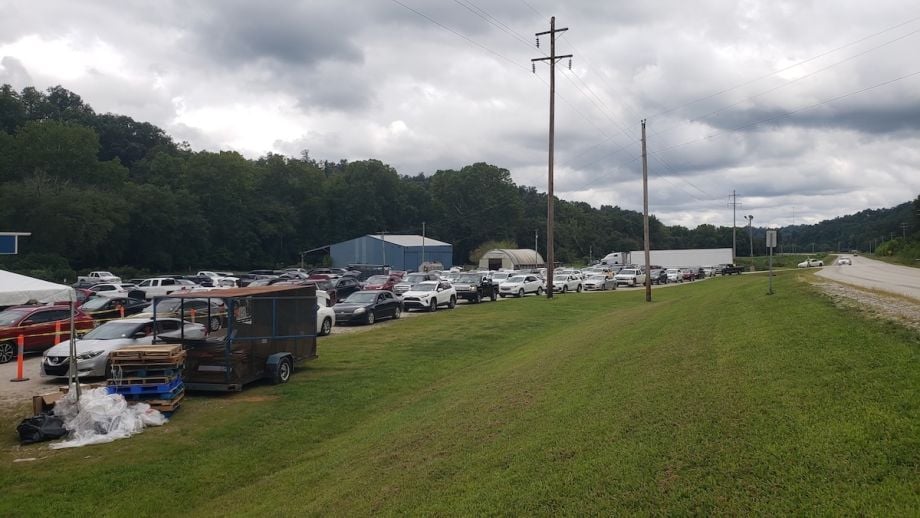Local food production doesn’t always look like a traditional rural farm, or even an urban half-acre plot. Sometimes, tilapia are involved.
FoodChain, another nonprofit food access organization in Lexington, began its work in 2011 targeting the city’s food insecurity through sustainability and education. They host free community meals, a free ingredient market, educational classes and the oldest public aquaponics farm in the state. A relatively new farming method, aquaponics cycles nutrients — namely, nitrogen — between plants in water beds and large tanks of fish.
“Feed can often end up being one of the highest costs for raising your fish. And these tilapia, they can live off of completely plant- and insect-based protein,” says Ethan Buland, FoodChain’s farm manager, gesturing to the piping across the in-house aquaponics farm. Every Saturday, he gives educational tours to show how FoodChain’s system cycles nutrients between rows of herbs and leafy greens, multiple fish tanks, and settling stations for waste filtration.
Nestled in Lexington’s historically Black Smithtown neighborhood, FoodChain operates out of a former Rainbo Bread Factory, sharing the expansive space with other social-needs nonprofits like Kentucky Refugee Ministries. FoodChain’s section of the old factory is now bustling again with a different food distribution model.
It starts in the aquaponics farm, and the produce then gets sold to nearby vendors or is used for their no-cost meals and market programs. These ingredients are also processed in their kitchen, many for kids’ cooking classes.
“Education and access go hand in hand,” says Kristin Hughes, co-executive director of FoodChain. “If you are just teaching somebody to cook and not giving them access to ingredients or tools, nothing’s going to happen. Same way if you’re giving somebody … all the kitchen utensils you need, but you’ve never taught them how to use any of them? They’re not going to use them to make something.”
FoodChain provides a wide variety of other services, including delivery and hot community meals. Whatever food isn’t grown in-house, FoodChain gets from chain food stores.
Their model is free for consumers, much like a food pantry. FoodChain’s education aspect is just one way they tackle stigma around free food programs. Hughes adds that it’s a community effort — many volunteers are also recipients – and in turn, these efforts create a space for community. Old friends, families and strangers sit at picnic tables across the street hours early to chat or reunite while going through distribution lines.
“Sometimes we feel like people come here because it’s social hour,” Hughes says. “It is an opportunity, especially as older populations sometimes get more and more isolated. Our meal distribution is an opportunity for folks who might not have a huge friend group to come together.”
John Rupp, the Nutrition Programs Director with God’s Pantry, has learned a similar lesson about food access programs.
“You have to build trust with the community, and how you do that is by being consistent.”
God’s Pantry is a longstanding food bank organization operating in nearly half of the state’s counties. Its distribution headquarters sits on the outskirts of Lexington. But in addition to stationary food pantries, Rupp says they’ve been having success with a more ‘mobile’ way to reach communities.
The Mobile Market, best described as a giant trailer, works to close the distance to fresh food. The market spends about two hours at more than a dozen locations every week. When the truck pulls into a neighborhood, it’s yet another opportunity for residents to come together as a community. The market’s schedule is easily accessible online, and Rupp says many shoppers are already waiting outside before the mobile market pulls up.
The program is a collaborative effort between God’s Pantry, Kroger and the City of Lexington. The Mayor’s Commission for Racial Justice and Equity kickstarted the process in 2020 as a way to address food insecurity for Lexington’s Black, Indigenous and non-white communities, many being low-income and low-access. The City funds the operation; Kroger stocks the truck; God’s Pantry puts the truck on the road.
A traveling grocery set-up is not in of itself a unique concept; Blacksoil runs a market on wheels to meet their neighborhood’s needs, and FoodChain delivers meals and ingredient boxes. But large institutional partnerships boost the Mobile Market’s success, enabling the market to reach many corners of town.
Shoppers walk in and find the same produce they could see in their closest Kroger, but without the extensive drive times. It costs the same too.
“One of God’s Pantry’s mottos is, we go to where the neighbor is,” Rupp says. “We meet you where you’re at. I think that’s just the power of it … Why not just come to you, instead of you having to figure out how to get to the store?”
In urban Lexington, a bus stop might be at least a mile walk away from home. These low-income, low-access areas pervade the city, where the Mobile Market intentionally sets up weekly. The further from Lexington, however, the less access to public transit.
The nonprofit provides services more akin to a standard pantry across central and eastern Kentucky, running stationary no-cost pantries and food drop offs in collaboration with dozens of local organizations and churches. They rescue surplus food from chain grocers and superstores across the region. One of their partner organizations, the Hazel Green Food Project, also provides services to an expanding area.
Hazel Green Food Project: ‘Without stipulations’

The Hazel Green Food Project relieds on volunteers to retrieve and distribute surplus food. (Photo by Anabel Peterman)
Lee City is about an hour’s drive from Lexington down the Bert T. Combs Mountain Parkway. If you spot a mile-long line of cars on the road there, there’s a good chance it’s a Hazel Green Food Project pick-up spot.
The Hazel Green Food Project, named after its homeplace — Hazel Green, with a population of nearly 200 people — is a newer food pantry nonprofit. The program began in 2021 as the COVID-19 pandemic ravaged the low-income region. Devastating floods throughout eastern Kentucky in 2022 only exacerbated the need for fresh food. Since then, Hazel Green Food Project has relied on volunteer effort to retrieve and distribute surplus food.
Families arrived hours early to the Lee City Stockyard in Wolfe County for the Munchkin Market at the beginning of August. In return, they got fruit, pantry staples, hygiene products and more. If volunteers spotted a child in the car, they packed in a bag of new toys or plushies.
These distributions are now regular events throughout Wolfe County, put together in partnership with the Christian Appalachian Project (CAP). CAP has operated with God’s Pantry and about 1,500 more partners for decades.
Operation Sharing, the CAP project working with Hazel Green, intentionally expands their supplies beyond fresh food; earlier this year, they gave out mattresses. This time, some boxes had hearing aid batteries. Aaron Thoms, program manager of operation sharing with CAP, explains those non-edible items are still fulfilling their mission of making food more accessible.
“It can offset [costs] for them to buy food,” says Thoms. “I have four children. And late July, early August hurts my wallet a little bit more because of the school system, schools going back … I’m not the only one who sees that.”
More than a dozen pallets of surplus peaches and nectarines were brought in from a farm in Virginia. Hazel Green and CAP get produce from The Farmink Project, which connects surplus produce to distributors like Hazel Green. It’s not always local, but the food still travels directly from farmers to consumers.
In the Munchkin Market line, a driver with kids in tow said they came from Morehead, Kentucky — about 45 minutes away. One of the first cars in line waited “about two hours.” They sacrifice their time for this food and supplies in an area with almost no public transit available and almost no grocery stores closer to home. Nickey Stacey, the President of Hazel Green Food Project, says the need is great enough that it’s worth the wait.

The stockyard lot held about 60 cars, and the line extended as far as two miles when pickup began. (Photo by Anabel Peterman)
“When they leave this parking lot, especially today, they’ve got hundreds of dollars of merchandise in the back of their car. So it makes it worth it, especially for larger families,” Stacey says. Her fellow volunteers agree this access is vital for almost anyone in the area hoping to eat fresh food, as local stores have few options and rising prices.
“I would love to shop local, but that’s the beauty of all these goods being brought into here. From CAP, from Farmlink. It really helps a lot of people,” says longtime volunteer Jenny Vest.
Hazel Green Food Project also works directly with judge executives across county lines, spreading their influence and bringing truckloads of fresh food.
What it means
Food deserts dry up communities when there is no access to fresh food at affordable prices, both for industrially isolated sects of cities and county wide stretches. Without locally produced food, or at least local shopping options, these places can not healthily sustain themselves. In this fight, organizations have found some common ground in how they make an impact.
Each of these nonprofits stressed they do not ask for proof of need. Shoppers at the Mobile Market don’t need to live where it stops or tick any eligibility boxes; anyone can come to the Farmacy Market and engage in their workshops, and their farmers don’t need a certain acreage. There are no income requirements to get a meal from FoodChain or take a cooking class, and every car coming through the Hazel Green Food Project’s line gets the same items, regardless of age or price.
None of these programs start with the consumer, either. In Black Soil and FoodChain’s models, healthy food access starts when the crop is planted. God’s Pantry and Hazel Green Food Project, through The Farmlink Project, take what food is already around and redistribute it equitably. They each take a different focus, but all of them provide forms of stationary pick-up and mobile services to reach their people.
Tina Bryson is the Director of Communications with CAP. She says homegrown organizations like Hazel Green, FoodChain and Black Soil show it takes strong local effort to get resources into the communities that need them most. It also takes heavy collaboration.
“In our local communities, we can address these issues one piece at a time and we can see the commonality between what happens in an urban area and what happens in a rural area,” says Bryson. “Then we see Kentucky as a whole, and we don’t get into these silos where we fight for resources.”







